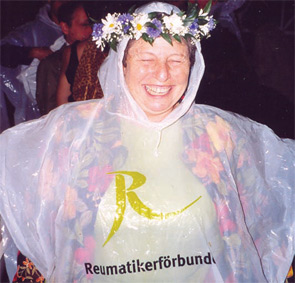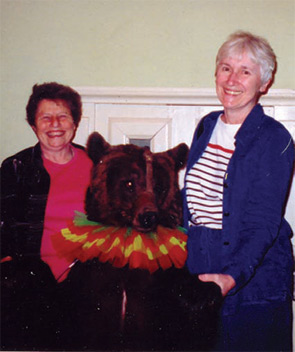By the time Kate Lorig, RN, DrPH, finished nursing school at Boston University in 1964, she knew that she would pursue community health nursing. “Basically,” she says, “I didn’t like hospitals! I liked meeting people and talking to them in their homes.” And indeed, Dr. Lorig’s initial attraction to community health nursing has informed her life’s work—the fruits of which now have a worldwide reach.
As a colleague and collaborator with her mentor, Halsted Holman, MD—the Guggenhime Professor of Medicine, Emeritus, at Stanford Medical School in Stanford, Calif.—Dr. Lorig has become a tireless champion in advancing the concept of efficacious patient self-management. She is currently director of Stanford University School of Medicine’s Patient Education Research Center. Through successful research collaborations and Dr. Lorig’s dedication to disseminating knowledge, the first Arthritis Self-Management Program became the prototype for additional self-management programs in chronic disease, HIV, back pain, and diabetes. The arthritis, chronic disease, and diabetes programs are replicated in Spanish, and several programs are now available online through Stanford University and through distribution partnerships with other agencies.
Mentors Along the Way
The idea of layperson-led patient education was considered radical when work began on the foundational Arthritis Self-Management Program in the late 1970s. But Dr. Lorig had already seen the effectiveness of this approach in other settings. As a public health nurse during a stint with the Peace Corps in Chile in the mid-1960s, she helped set up a public health nursing service for Valdivia, a city of 100,000 people. Workers with 10 to 12 years of education and one year of specialized, focused training did maternal and child health, delivered anesthesia, or worked in pharmacies. Back in the United States, she volunteered for a year at the Haight Ashbury Free Clinic, then moved to the Alviso Family Health Center in Alviso, Calif., where she worked as a healthcare curriculum developer and trained community health workers. At the Alviso Family Health Center, she was able to further her interest, sparked during her tour with the Peace Corps, in working with underserved Hispanic communities. Her position as professional coordinator for the International Confederation of Midwives entailed more travel, for organizing family planning conferences in Africa and Latin America.
In each of these settings, Dr. Lorig was inspired by the willingness of her colleagues to try new things. It was also historically a much different time. The Kennedy years, the War on Poverty, the movement to examine healthcare inequities, and the shift to community-based education all contributed, recalls Dr. Lorig, to a time of tremendous innovation. “I sometimes feel sorry that young people today don’t have the same opportunities we had” to be as experimental, she says.
Career Timeline
1968 – Receives MS in nursing from the University of California, San Francisco
1968 – Becomes training coordinator for the Alviso Family Health Center
1971 – Accepts position of community development specialist at the University of California Extension, Santa Cruz, Caif.
1974 – Becomes professional coordinator for the International Confederation of Midwives
1980 – Receives DrPH in health education from the University of California, Berkley
1985 – Becomes clinical associate professor of immunology and rheumatology at the University of California, San Francisco
1987 – Accepts position as senior research scientist at Stanford University School of Medicine
1995 – Becomes associate professor of immunology and rheumatology at Stanford
2002 – Promoted to professor of immunology and rheumatology at Stanford
Lured to Stanford
In the late 1970s, Dr. Lorig planned to obtain her doctorate in health education at the University of California, Berkeley, and she applied for a job with Stanford University to help finance her graduate studies. The Midpeninsula Health Service organized by Dr. Holman, Stan Shoor, MD, and others had obtained federal Multipurpose Arthritis Center funding to further its work with patient education in an aging arthritis patient population. The funding for the center grant required an educational research component, and that’s where Dr. Lorig came in.
Because her focus and expertise were in maternal and child health, Dr. Lorig’s initial response was to turn the job down. “I’m not really interested in arthritis,” she told Dr. Holman when he proposed she come to work with their team. She also felt the project would be too time consuming while pursuing her thesis. But when Dr. Holman offered to help pay for her dissertation, it became an offer she couldn’t refuse. “He’s very good at bribes,” Dr. Lorig jokes about her long-time mentor and colleague.
She notes that she has always truly appreciated Dr. Holman’s openness to new thoughts and new ways of serving the public, as long as they seem worthwhile. “He was willing to work with a nonphysician and a woman. Very few physicians would take seriously a doctoral student who was a nurse. He was well before his time.” When questioned on this point, Dr. Holman says simply, “I didn’t give it a second thought. What she offered was a person with an interesting background that had included nontraditional medical activities. We had a practical program trying to help patients learn to take care of themselves better. We recognized that we would get nowhere in the long run unless we were able to prove that what we were doing worked. With Kate, it was possible to set up an investigative program to test self-management education.”
Since the initial research project (a randomized trial that revealed better outcomes and lower costs for patients who underwent the educational component of the plan1), the two have collaborated on designing the Arthritis Self-Management Program and the subsequent Chronic Disease Self-Management Program, and have contributed to development of the Chronic Care Model of practice created by the Improving Chronic Illness Care program of the Robert Wood Johnson Foundation.
Staying at Stanford
From 1978 until 1987, Dr. Lorig was a research associate at the Stanford Arthritis Center, School of Medicine. She was a senior research scientist from 1987 to 1995; an associate professor from 1995 to 2002, and a full professor in the division of immunology and rheumatology of the department of medicine at Stanford from 2002 onward. Since 1985, she has also served as clinical associate professor in the School of Nursing at the University of California, San Francisco. Diana Laurent, MPH, a Patient Education Center staff member who develops curriculum materials and maintains the Center’s Web site and chronic disease, arthritis, and diabetes online projects, notes that finding a fit within the School of Medicine was not always easy. “They [the administration] dealt with clinical personnel as opposed to people doing health education. They didn’t exactly know what to do with us—in the early days, Kate’s job title was actually ‘miscellaneous professional’!”
Given Dr. Lorig’s initial reluctance to work with arthritis, what changed her mind and resulted in her 30-year career at Stanford? “I did the first project, and then two things happened,” she recalls. “I began to truly understand that arthritis is a surrogate for all chronic illness. Hal and Jim Fries [initiator of ARAMIS] were always so eloquent in talking about the coming crisis in chronic illness, which was not something that I’d ever considered much before.” The other reason was the Robert Wood Johnson Clinical Scholars Program: “Since I didn’t have any nursing colleagues at Stanford, I was really a poor fit. The clinical scholars became my colleagues and my playmates—they were just such a remarkable, remarkable group of people!” And finally, she says: “I couldn’t find anything I wanted to do more.”

Stature as a Scientist
Dr. Lorig has spent a career dedicated to interventional studies with practical applications and practical value to those living with chronic diseases, notes Nancy Whitelaw, PhD, senior vice president for the National Council on Aging (NCOA) and director of the Center for Healthy Aging, both in Washington, D.C., who describes Dr. Lorig as “one of my heroes!” Dr. Whitelaw explains, “The questions she’s asking in her science are about issues and problems that are real to people. Her work is informed by strong theory that she interprets and puts into place in very appropriate ways.” In addition, she says, Dr. Lorig has the “guts and commitment” to put together a national training program, complete with all the tools and materials, that enables organizations to acquire the necessary skills to replicate her interventions. “It’s not easy, in this world of medicalization that we live in, to be passionate about self-care and self-management. But then, you know, she is no shrinking violet!” she notes.
“The bottom line is that Kate has always exhibited a passion for helping people help themselves,” says Michele Boutaugh, BSN, MPH, group vice president for programs and services for the Arthritis Foundation (AF) in Atlanta. Boutaugh has worked with Dr. Lorig since 1981, when the AF first field-tested the Arthritis Self-Management program. Through the AF, the program has reached thousands of people. “Like the parable about teaching people to fish rather than giving them fish, Kate’s life’s work has been about helping people learn skills and how to manage their disease so that they can handle any challenge that comes their way,” notes Boutaugh.
The Arthritis Self-Management Program focuses on the need for changing behaviors and learning new health habits that will help people on a day-to-day basis with their arthritis. Pain management and relaxation techniques are taught throughout the six-week course so that participants have the opportunity to learn and practice these skills over time. Building self-efficacy, also a core theme of the course, “gives it a much more powerful outcome than a traditional didactic course,” notes Boutaugh.
Extended Acceptance
Dr. Lorig began to challenge mainstream medicine again in the early 1990s, when she wondered whether the tenets of patient self-management could be extended to all chronic diseases. She recalls an seminal lecture given by Len Syme, a professor of epidemiology while she was at Berkeley. “That had been in the back of my mind: could you put people with different chronic illnesses together? If someone is living in the community, they may have two or three chronic conditions, so you really have to consider them as a whole if you’re going to help that individual. At that point, I really wanted to expand out and try that. Thankfully, Hal was willing to let me try.” She and several investigators, many of whom had collaborated on the Arthritis Self-Management Program, set out to test whether a Chronic Disease Self-Management Program (CDSMP) would be effective.
Randomized controlled trials of interventional modalities are challenging enough. Studies in groups of people with different chronic conditions pose additional obstacles, says Dr. Lorig. “In groups of people with mixed conditions, not everyone has the same symptoms, such as shortness of breath, fatigue, or depression, so this mutes the effects that can be seen.” Nevertheless, the evidence began to show that the CDSMP could improve health status as well as reduce utilization costs.2,3 When the project began, says Laurent, who along with Dr. Lorig and Virginia González wrote the program, “It was like the old days all over again! We had to convince a whole other group of health professionals. But, we know that the way to convince people is to give them evidence.” As studies began to reveal positive results from the CDSMP, the Administration on Aging began funding the program, which is now in 26 states.
“The acceptance [of chronic disease self-management] is coming,” says Dr. Lorig. “What’s really interesting to me is that the acceptance came through aging.”
“Literally everyone is now on the chronic disease bandwagon, in that they recognize that chronic disease is a huge and growing expense, and that 95% of care should be self-care,” says Jay Greenberg, ScD, executive vice president of business development for the NCOA. “But for a lot of years, that acceptance was not the case.”
Like his counterparts in other patient and consumer advocacy organizations, Dr. Greenberg credits Dr. Lorig with helping to propel self-management programs into the mainstream. He is excited about the partnership NCOA inked with Stanford in March 2008 to host and distribute the CDSMP online. “Some people with chronic conditions need to be in a room with other people and some prefer to be anonymous,” he says. “The notion of a self-care program that allows for both social networking and anonymity is really exciting.”

Of Projects, Mentoring, and Mushrooms
Between the demands of current research projects (one currently looking at using the Internet to attract more patients to self-management courses), world travel, and partnering with advocacy organizations, does she have any free time? “Free time?” Dr. Lorig chuckles. “Well, yes, I actually do have a little.” She likes being in the outdoors, so gardening and hunting for wild mushrooms are activities she enjoys. Also high on her list: attending ballet performances and collecting Native American folk dolls and handcrafts (her collection fills several walls in her house, according to Laurent).
Another activity for which Dr. Lorig always finds time, says Laurent, is mentoring. “I really think Kate’s favorite role in life is that of mentor,” she asserts. “She likes to develop people and see them grow.” Laurent was one of those people, recruited by Dr. Lorig from San Jose State, where she was a part-time faculty member, to come to the Patient Education Center in 1986.
Dr. Lorig’s mentoring extends to partner organizations, note Drs. Whitelaw and Greenberg. Developing the agreement between Stanford and the NCOA took many bureaucratic twists and turns, says Dr. Greenberg, but throughout the process Dr. Lorig was “a great colleague,” he enthused. “She’s a problem solver and respects the arenas in which she’s not an expert. Kate appreciates that it takes a team to make all of this stuff happen. And that’s rare. She’s getting the recognition she deserves, and to her credit, it doesn’t go to her head.”
Gretchen Henkel is writing the “Metrics in Rheumatology” series.
References
- Lorig K, Laurin J, Holman HR. Arthritis self-management: A study of the effectiveness of patient education for the elderly. Gerontologist. 1984;24:455–457.
- Lorig KR, Sobel DS, Steward AL, et al. Evidence suggesting that a chronic disease self-management program can improve health status while reducing hospitalization: A randomized trial. Medical Care. 1999;37:5–14.
- Lorig KR, Ritter P, Stewart AL, et al. Chronic Disease Self-Management Program: 2-Year Health Status and Health Care Utilization Outcomes. Medical Care. 2001;39:1217–1223.
